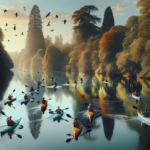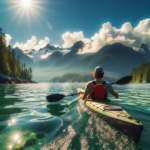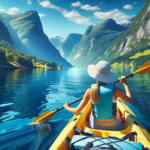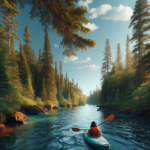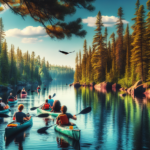Kayaking in Orange River, South Africa/Namibia
Introduction to Kayaking
Kayaking is an exhilarating outdoor activity that has gained immense popularity worldwide. It offers a unique blend of adventure, exercise, and a chance to connect with nature. Whether you’re navigating through serene lakes, challenging river rapids, or exploring coastal waters, kayaking provides a thrilling experience that caters to both beginners and seasoned paddlers. The sport’s versatility and the sense of freedom it offers make it a favorite among outdoor enthusiasts.
In this article, we will spotlight the unique features of kayaking in the Orange River, which flows through South Africa and Namibia. This destination is renowned for its stunning landscapes, diverse wildlife, and the exciting kayaking opportunities it presents. Our goal is to provide you with a comprehensive guide to kayaking in this region, covering everything from the best spots to safety regulations and environmental considerations.
Kayaking in the Orange River is a unique experience due to its diverse geography and rich cultural history. The river’s journey through arid landscapes, lush vineyards, and dramatic canyons offers kayakers a variety of scenic views and challenges. Additionally, the region’s historical significance and cultural ties to water sports add an extra layer of intrigue to your kayaking adventure.
Overview of Kayaking in Orange River, South Africa/Namibia
The Orange River, also known as the Gariep River, is the longest river in South Africa, stretching over 2,200 kilometers. It originates in the Drakensberg Mountains in Lesotho and flows westward, forming the border between South Africa and Namibia before emptying into the Atlantic Ocean. The river’s diverse geography includes rugged canyons, fertile valleys, and expansive desert landscapes, making it an ideal location for kayaking.
The climate along the Orange River varies significantly depending on the region. In the upper reaches, the climate is temperate with moderate rainfall, while the lower stretches near the Namibian border experience arid conditions with hot summers and mild winters. This variation in climate means that different sections of the river offer unique kayaking experiences throughout the year.
Accessing the Orange River for kayaking is relatively straightforward. Major entry points include the towns of Upington and Vioolsdrif in South Africa, as well as Noordoewer in Namibia. These towns are well-connected by road and offer various amenities for travelers. The best time to visit for kayaking is during the spring and autumn months when the weather is mild, and water levels are optimal.
Historically, the Orange River has been a vital water source for indigenous communities and settlers. Its significance in local culture and history is evident in the numerous archaeological sites and rock art found along its banks. Today, the river continues to play a crucial role in the region’s economy, supporting agriculture, tourism, and recreational activities like kayaking.
Kayaking Conditions in Orange River, South Africa/Namibia
The Orange River offers a variety of water conditions suitable for different levels of kayaking expertise. The river’s flow varies from gentle, meandering stretches ideal for beginners to more challenging rapids that attract experienced kayakers. The river’s diverse conditions ensure that there is something for everyone, regardless of skill level.
Weather conditions along the Orange River can significantly impact kayaking experiences. In the upper regions, the climate is more temperate with occasional rainfall, which can lead to higher water levels and faster currents. In contrast, the lower regions near the Namibian border are arid, with hot summers and mild winters. It’s essential to check weather forecasts and water levels before planning your trip to ensure a safe and enjoyable experience.
Tides and water currents in the Orange River are influenced by seasonal rainfall and snowmelt from the Drakensberg Mountains. During the rainy season, typically from November to March, water levels can rise, creating more challenging conditions for kayakers. Conversely, the dry season from April to October offers more stable and predictable water levels, making it an ideal time for kayaking.
Environmental factors such as wind and temperature can also affect kayaking conditions. Strong winds can create choppy waters, making navigation more difficult, while extreme temperatures can impact your comfort and safety. It’s crucial to be prepared for these conditions by wearing appropriate gear and staying hydrated.
Top Spots for Kayaking in Orange River, South Africa/Namibia
One of the top spots for kayaking on the Orange River is the Richtersveld Transfrontier Park. This area is known for its rugged, mountainous terrain and stunning desert landscapes. The park offers a range of kayaking routes, from gentle paddles through calm waters to more challenging sections with rapids. The best time to kayak here is during the cooler months from April to September.
Another popular kayaking destination is the section of the river near Augrabies Falls National Park. This area is famous for its dramatic waterfalls and unique rock formations. Kayakers can enjoy a mix of calm stretches and exciting rapids, all while taking in the breathtaking scenery. The best time to visit is during the spring and autumn months when the weather is mild, and water levels are optimal.
The stretch of the Orange River near the town of Upington is also a favorite among kayakers. This area is characterized by its lush vineyards and fertile valleys, offering a more tranquil kayaking experience. The calm waters and beautiful scenery make it an ideal spot for beginners and those looking for a relaxing paddle. The best time to visit is during the spring and autumn months.
For those seeking a more remote and adventurous experience, the section of the river near Noordoewer in Namibia is a must-visit. This area offers a mix of calm waters and challenging rapids, set against the backdrop of the Namib Desert. The best time to kayak here is during the cooler months from April to September, when temperatures are more manageable.
Safety and Regulations
Safety is paramount when kayaking on the Orange River. Local regulations require all kayakers to wear life jackets and carry essential safety gear, including a whistle, a first aid kit, and a waterproof map of the area. It’s also recommended to paddle in groups and inform someone of your planned route and expected return time.
Before embarking on your kayaking adventure, it’s essential to familiarize yourself with the river’s conditions and potential hazards. This includes understanding the river’s flow, identifying any rapids or obstacles, and being aware of weather forecasts. Local guides and tour operators can provide valuable insights and assistance in planning your trip.
In case of an emergency, it’s crucial to know how to handle various situations. This includes capsizing, getting caught in a rapid, or dealing with extreme weather conditions. Taking a kayaking safety course or participating in guided tours can help you develop the necessary skills and confidence to handle emergencies effectively.
Respecting local regulations and guidelines is essential for ensuring a safe and enjoyable kayaking experience. This includes adhering to designated camping areas, avoiding restricted zones, and following Leave No Trace principles to minimize your impact on the environment.
Amenities and Accommodations
The Orange River region offers a range of amenities to support your kayaking adventure. Several rental facilities provide kayaks, paddles, life jackets, and other essential gear. Additionally, local guides and tour operators offer guided kayaking trips, which can be a great way to explore the river safely and learn more about the area’s history and wildlife.
Accommodation options along the Orange River cater to various preferences and budgets. For those who enjoy camping, there are numerous campsites along the riverbanks, offering basic facilities and stunning views. These campsites provide a more immersive experience, allowing you to connect with nature and enjoy the tranquility of the river.
If you prefer more comfortable accommodations, there are several lodges and guesthouses in towns like Upington, Vioolsdrif, and Noordoewer. These establishments offer a range of amenities, including comfortable rooms, dining options, and sometimes even guided tours and activities. Staying in a lodge or guesthouse can provide a convenient base for your kayaking adventures.
In addition to kayaking, the Orange River region offers various recreational activities for visitors to enjoy. These include hiking, bird watching, fishing, and exploring local cultural and historical sites. Taking advantage of these activities can enhance your overall experience and provide a well-rounded adventure.
Environmental Considerations
Preserving the natural habitats and wildlife along the Orange River is crucial for maintaining the area’s ecological balance. As kayakers, it’s essential to practice eco-friendly habits to minimize your impact on the environment. This includes avoiding disturbing wildlife, staying on designated paths, and disposing of waste properly.
One of the key principles of eco-friendly kayaking is to follow Leave No Trace guidelines. This means packing out all your trash, minimizing campfire impact, respecting wildlife, and being considerate of other visitors. By adhering to these principles, you can help preserve the natural beauty of the Orange River for future generations.
Several local conservation efforts and projects aim to protect the Orange River’s unique ecosystems. These initiatives focus on preserving water quality, protecting endangered species, and promoting sustainable tourism practices. Supporting these efforts through donations or volunteer work can make a positive impact on the environment.
Educating yourself about the local flora and fauna can enhance your kayaking experience and foster a deeper appreciation for the region’s natural beauty. Understanding the importance of conservation and taking proactive steps to protect the environment can help ensure that the Orange River remains a pristine destination for kayaking enthusiasts.
Highlights
When comparing kayaking in the Orange River to other popular kayaking destinations, several unique features stand out. The river’s diverse geography, ranging from lush valleys to arid deserts, offers a variety of scenic views and challenges that are hard to find elsewhere. Additionally, the region’s rich cultural history and archaeological sites add an extra layer of intrigue to your kayaking adventure.
The Orange River is home to a unique biodiversity, with several endemic species of plants and animals. This includes various bird species, fish, and reptiles that are not found in other parts of the world. Kayaking through this diverse ecosystem provides a rare opportunity to observe and appreciate these unique species in their natural habitat.
Geographically, the Orange River’s journey through dramatic canyons, fertile valleys, and expansive desert landscapes offers a range of kayaking experiences that cater to different skill levels. Whether you’re navigating through calm waters or tackling challenging rapids, the river’s diverse conditions ensure an exciting and memorable adventure.
The historical significance of the Orange River adds another dimension to your kayaking experience. The river has been a vital water source for indigenous communities and settlers for centuries, and its banks are dotted with archaeological sites and rock art that tell the story of the region’s rich cultural heritage.
FAQ Section
- What is the best season to go kayaking on the Orange River? The best seasons are spring (September to November) and autumn (March to May) when the weather is mild, and water levels are optimal.
- Are there beginner-friendly spots for kayaking on the Orange River? Yes, sections near Upington and the lower stretches of the river offer calm waters suitable for beginners.
- What should I bring for a kayaking trip on the Orange River? Essential items include a life jacket, paddle, waterproof map, first aid kit, sunscreen, hat, and plenty of water.
- Are kayak rentals available, and what are the costs? Yes, several rental facilities offer kayaks and gear. Costs vary but typically range from $20 to $50 per day.
- How can I participate in local conservation efforts? You can support local conservation projects through donations or volunteer work. Many organizations focus on preserving water quality and protecting wildlife.
- Are guided kayaking tours available, and what do they cover? Yes, guided tours are available and often include equipment rental, safety briefings, and information about the area’s history and wildlife.
- What safety measures are in place for kayaking on the Orange River? Local regulations require life jackets and essential safety gear. It’s also recommended to paddle in groups and inform someone of your planned route.
Final Thoughts
Kayaking in the Orange River, South Africa/Namibia, is a premier destination for kayaking enthusiasts due to its diverse geography, rich cultural history, and unique biodiversity. The river offers a range of kayaking experiences, from tranquil paddles through lush valleys to challenging rapids in dramatic canyons. Whether you’re a beginner or an experienced paddler, the Orange River has something to offer.
Respecting local guidelines and conservation efforts is crucial for preserving the natural beauty and ecological balance of the Orange River. By practicing eco-friendly habits and supporting local conservation projects, you can help ensure that this stunning destination remains pristine for future generations.
In conclusion, kayaking in the Orange River is an unforgettable adventure that combines the thrill of paddling with the opportunity to explore one of the most beautiful and diverse regions in Southern Africa. We invite you to experience the beauty and excitement of kayaking in the Orange River and create memories that will last a lifetime.


